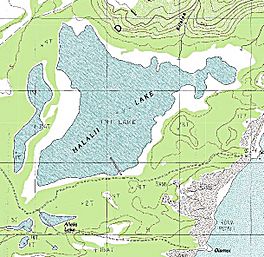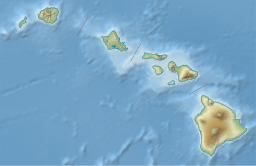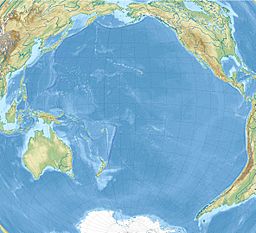Halalii Lake facts for kids
Quick facts for kids Hālaliʻi Lake |
|
|---|---|
 |
|
| Location | Niʻihau |
| Coordinates | 21°51′18″N 160°11′10″W / 21.855°N 160.186°W |
| Catchment area | 840.7 acres (340.2 ha) |
| Basin countries | United States |
Hālaliʻi Lake is a special lake on the island of Niʻihau. Niʻihau is the smallest island in Hawaii where people live. Hālaliʻi Lake is an ephemeral lake. This means it doesn't always have water. It appears and disappears depending on the rain.
During the rainy season, Hālaliʻi Lake becomes the biggest lake in all the Hawaiian Islands. It is located close to another lake called Halulu Lake. Halulu Lake is known as the largest natural lake in Hawaii that always has water.
How Big is Hālaliʻi Lake?
Hālaliʻi Lake can be very large during the rainy season. It measures about 840.7 acres (340.2 ha). That's like more than 600 football fields!
But Niʻihau is a very dry island. When there isn't much rain, the lake dries up. It turns into a flat, reddish area. Sometimes, small salty pools of water are left behind. Because the water level changes so much, some people don't always call it a true lake.
What Does the Name Mean?
Hawaiian language experts have studied the name Hālaliʻi. They believe the lake and the land around it were named after its owner. This owner was either a Hawaiian high chief, called an aliʻi, or a trickster god from the island of Oʻahu.
Hālaliʻi and Halulu were both important chiefs on Niʻihau. There is also a volcanic hill on the island of Maui that shares the name Hālaliʻi.
Plants Around the Lake
A special grass-like plant called Makaloa sedge grows along the lake's edges. Its scientific name is Cyperus laevigatus. Native Hawaiians traditionally used this plant. They would weave its strong fibers into beautiful Makaloa mats.
The lake bed was also used to grow sugarcane. It was famous because the sugarcane grew "in the sand with only leaves sticking out." This shows how tough these plants were!
Animals and Fish
Hālaliʻi Lake is a natural wetland. A wetland is an area of land that is covered by water, or has waterlogged soil, for at least part of the year. This wetland provides a home for many Hawaiian bird species. These include the ʻalae keʻokeʻo (Hawaiian coot), the aeʻo (Hawaiian stilt), and the koloa maoli (Hawaiian duck).
The lake is also used for farming mullet fish. Hawaiians bring baby mullets, called pua, from the sea in barrels. They release them into the lake during the rainy season. Then, when the water goes down in the summer, they catch the grown fish.
In Halulu Lake, fish can swim into the lake from the sea through underground lava tubes when they are young. The grown fish from Hālaliʻi Lake are often sold in markets on the islands of Kauaʻi and Oʻahu.



